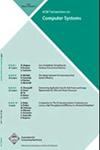能量感知无损数据压缩
IF 1.8
4区 计算机科学
Q2 COMPUTER SCIENCE, THEORY & METHODS
引用次数: 403
摘要
无线传输一个比特需要的能量是一次计算的1000多倍。因此,执行额外的计算以减少传输的比特数可能是有益的。如果压缩数据所需的能量少于发送数据所需的能量,那么就会节省净能量,并增加便携式计算机的电池寿命。本文介绍了在传输前对数据进行无损压缩可能节省的能源的研究。在StrongARM SA-110处理器上测量了各种算法。这项工作表明,使用几种典型的压缩算法,在传输前进行压缩实际上会增加净能量。解释了这种增长的原因,并提出了避免这种增长的建议。其中一个对能量敏感的建议是不对称压缩,即在发送端使用一种压缩算法,而在接收路径上使用不同的算法。通过在测试平台上选择能量最低的压缩机和减压器,与精心选择的对称对相比,发送和接收数据的总能量可减少11%,或比默认的对称zlib方案最多减少57%。本文章由计算机程序翻译,如有差异,请以英文原文为准。
Energy-aware lossless data compression
Wireless transmission of a single bit can require over 1000 times more energy than a single computation. It can therefore be beneficial to perform additional computation to reduce the number of bits transmitted. If the energy required to compress data is less than the energy required to send it, there is a net energy savings and an increase in battery life for portable computers. This article presents a study of the energy savings possible by losslessly compressing data prior to transmission. A variety of algorithms were measured on a StrongARM SA-110 processor. This work demonstrates that, with several typical compression algorithms, there is a actually a net energy increase when compression is applied before transmission. Reasons for this increase are explained and suggestions are made to avoid it. One such energy-aware suggestion is asymmetric compression, the use of one compression algorithm on the transmit side and a different algorithm for the receive path. By choosing the lowest-energy compressor and decompressor on the test platform, overall energy to send and receive data can be reduced by 11% compared with a well-chosen symmetric pair, or up to 57% over the default symmetric zlib scheme.
求助全文
通过发布文献求助,成功后即可免费获取论文全文。
去求助
来源期刊

ACM Transactions on Computer Systems
工程技术-计算机:理论方法
CiteScore
4.00
自引率
0.00%
发文量
7
审稿时长
1 months
期刊介绍:
ACM Transactions on Computer Systems (TOCS) presents research and development results on the design, implementation, analysis, evaluation, and use of computer systems and systems software. The term "computer systems" is interpreted broadly and includes operating systems, systems architecture and hardware, distributed systems, optimizing compilers, and the interaction between systems and computer networks. Articles appearing in TOCS will tend either to present new techniques and concepts, or to report on experiences and experiments with actual systems. Insights useful to system designers, builders, and users will be emphasized.
TOCS publishes research and technical papers, both short and long. It includes technical correspondence to permit commentary on technical topics and on previously published papers.
 求助内容:
求助内容: 应助结果提醒方式:
应助结果提醒方式:


